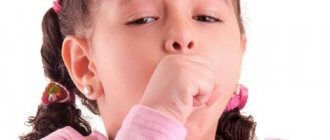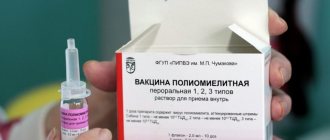Risk factors
The main causes of bronchitis in children:
- spread of infection to the bronchi due to acute respiratory viral infections, influenza or a severe cold;
- hypothermia of the body;
- congenital anomalies of the child’s respiratory system;
- extensive helminthic infestations.
The development of the disease is provoked by sharp seasonal temperature changes and high humidity, so the incidence of bronchitis increases in the autumn-spring period.
At risk are children who are forced to be among smokers, in cold and damp rooms, as well as those attending schools and preschool institutions.
What should not be done if you have bronchitis?
If the symptoms of bronchitis are acute in a child, parents are advised to ensure complete rest for the patient and avoid walking outside, as well as any type of physical activity in the first days of the disease, especially at high temperatures. In the chronic form, on the contrary, it is important to walk with the child in the fresh air in places far from highways. It is prohibited to subject the patient to water procedures.
It is strictly not recommended to do inhalations with saline and soda solutions and using herbal ingredients for patients with a productive cough and children suffering from bronchitis due to asthma. At high temperatures, avoid rubbing, warming the chest and back area, and applying compresses using animal fats.
Folk remedies for bronchitis in children are not recommended to be used without prior consultation with the attending physician.
Diagnostic methods
The primary diagnosis of bronchitis in children is based on clinical data (the nature of cough and sputum, characteristics of the course, etc.) and the results of auscultation (scattered dry and moist wheezing of various sizes can be heard, wheezing in case of bronchial obstruction).
After making the initial diagnosis, laboratory tests for bronchitis in children and instrumental studies are prescribed to confirm it:
- sputum analysis (PCR examination, bacteriological culture, microscopic analysis, etc.);
- general and biochemical blood test;
- examination of smears from the larynx and nasopharynx;
- X-ray of the lungs;
- bronchography and bronchoscopy;
- spirography of the lungs.
Differential diagnosis is carried out with bronchial asthma, cystic fibrosis, pneumonia, tuberculosis and other diseases with a similar clinical picture.
Etiology
In the international classification of diseases, bronchitis is defined as:
- acute: characterized by an increase in bronchial secretion, cough, and sputum production. Is an inflammation of the mucous membrane of the tracheobronchial tree;
- chronic: a malfunction of the bronchi occurs when the protective and cleansing function of the organ is disrupted. The lesion is already progressive in nature, sputum production increases significantly, and the inflammatory process begins. Experts talk about the development of chronic bronchitis, when more than four exacerbations occur within twelve months, the patient is tormented by an incessant cough, which can last up to two years. Young children are especially at risk. Treatment is difficult and long, and preschoolers are more likely to develop asthma.
In addition to these two types, doctors often identify a third form of the disease - obstructive. With it, swelling of the mucous membrane develops, leading to blockage of the bronchi.
Different types of illness have their own etiology. Acute is caused by bacteria and viruses that enter the body aerogenically (by air). Pathogenic agents have a toxic effect on the organs of the respiratory system, causing inflammation.
Chronic bronchitis is caused by certain external factors:
- bad habits, in particular smoking. Systematic use of nicotine is the most common cause of severe cough and other associated symptoms (shortness of breath, chest pain);
- work in hazardous work, when a person is constantly in a smoky room or is forced to inhale dust and microscopic particles of something;
- immunodeficiency, when the body does not have enough protective forces to resist external influences.
Basic treatment methods and contraindications
How to treat bronchitis in children depends on the etiology of the disease. Antiviral drugs (Umifenovir hydrochloride, Rimantadine, etc.), antibiotics (penicillins, cephalosporins, macrolides), and antifungal agents may be prescribed. Mucolytics and expectorants (Ambroxol, Bromhexine, Mucaltin, breast preparations) must be prescribed.
Antipyretic drugs are used as needed. You can apply warming ointments and compresses to your chest (this is contraindicated for obstructive bronchitis).
To relieve cough, you can do steam inhalations. For bronchial obstruction, the use of aerosol bronchodilators is indicated. Antitussive drugs are prescribed with caution, as they have side effects.
For allergic bronchitis, antihistamines are indicated.
For viral bronchitis, it is recommended to gargle with medicinal or herbal solutions to relieve inflammation.
general information
The list of drugs that are prescribed for the treatment of bronchitis in children is established based on the clinical symptoms and causes of the disease.
Expectorants and mucolytics, taking into account the allergic condition of the child, are prescribed for any type of bronchitis to improve the cleansing of the bronchi.
Children with allergies and bronchospasm are prescribed bronchodilators and hormonal anti-inflammatory drugs to relieve shortness of breath.
Bronchitis during a cold is in the vast majority of cases viral in nature. Cough, increased body temperature for up to 5 days, absence of shortness of breath and pronounced inflammatory changes in the general blood test are symptomatic and pathogenetic. Immunomodulatory drugs, antiviral drugs, vitamins, non-hormonal anti-inflammatory drugs and drugs that improve sputum discharge are used.
If the elevated temperature lasts for more than 5 days, the sputum becomes purulent, and a blood test reveals leukocytosis - you cannot do without antibiotics for bronchitis. The appearance of shortness of breath, wheezing, indicating obstruction, against the background of the above symptoms is a reason for the urgent prescription of antibiotics.
Obstruction and cough without fever due to bronchitis, severe allergic history, require the use of bronchodilators and glucocorticoids. Asthmatic bronchitis can be treated without antibiotics.
Chronic bronchitis in children. Causes, symptoms, treatment
Chronic bronchitis in children is a long-term disease with periods of exacerbation. It develops with insufficient and untimely treatment, as well as with constant exposure to harmful factors (dust, allergens, gases, etc.). The most characteristic sign of chronic bronchitis is a prolonged cough, dry during remission, and wet during exacerbation, with the release of purulent mucous sputum. For exacerbations, treatment is the same as for acute bronchitis. Constant monitoring by a pediatrician and pediatric pulmonologist is required.
Bronchitis in children
The development of acute bronchitis in children in most cases is preceded by signs of a viral infection: sore throat, coughing, hoarseness, runny nose, conjunctivitis. A cough soon appears: obsessive and dry at the beginning of the disease, by 5-7 days it becomes softer, moist and productive with the separation of mucous or mucopurulent sputum. In acute bronchitis, a child experiences an increase in body temperature up to 38-38.5°C (lasting from 2-3 to 8-10 days depending on the etiology), sweating, malaise, chest pain when coughing, in young children - shortness of breath. The course of acute bronchitis in children is usually favorable; the disease ends with recovery on average after 10-14 days. In some cases, acute bronchitis in children can be complicated by bronchopneumonia. With recurrent bronchitis in children, exacerbations occur 3-4 times a year.
Acute bronchiolitis develops mainly in children of the first year of life. The course of bronchiolitis is characterized by fever, severe general condition of the child, intoxication, severe signs of respiratory failure (tachypnea, expiratory shortness of breath, cyanosis of the nasolabial triangle, acrocyanosis). Complications of bronchiolitis in children may include apnea and asphyxia.
Obstructive bronchitis in children usually manifests itself in the 2-3rd year of life. The leading sign of the disease is bronchial obstruction, which is expressed by paroxysmal cough, noisy wheezing, prolonged exhalation, and distant wheezing. Body temperature may be normal or low-grade. The general condition of children usually remains satisfactory. Tachypnea, shortness of breath, and participation of auxiliary muscles in breathing are less pronounced than with bronchiolitis. Severe obstructive bronchitis in children can lead to respiratory failure and the development of acute cor pulmonale.
Allergic bronchitis in children usually has a recurrent course. During periods of exacerbation, sweating, weakness, and cough with mucous sputum are noted. Body temperature remains normal. Allergic bronchitis in children is often combined with allergic conjunctivitis, rhinitis, atopic dermatitis and can develop into asthmatic bronchitis or bronchial asthma.
Chronic bronchitis in children is characterized by exacerbations of the inflammatory process 2-3 times a year, occurring sequentially for at least two years in a row. Cough is the most constant sign of chronic bronchitis in children: during remission it is dry, during exacerbations it is wet. Sputum is coughed up with difficulty and in small quantities; has a mucopurulent or purulent character. There is a low and variable fever. A chronic purulent-inflammatory process in the bronchi can be accompanied by the development of deforming bronchitis and bronchiectasis in children.
Symptoms and signs of bronchitis
Bronchitis most often manifests itself against the background of an acute respiratory disease. The viruses themselves prefer the upper respiratory tract, but the infection almost always reaches the bronchi4.
Before the child starts coughing and the doctor diagnoses bronchitis, symptoms characteristic of acute respiratory diseases appear. The following symptoms and signs of bronchitis in children may appear:
- Heat;
- Headache, anxiety;
- Weakness, decreased activity, muscle pain, constant fatigue
- Runny nose, manifesting itself in the form of nasal congestion, mucous discharge;
- Sore throat, sore throat, hoarseness;
- The most characteristic symptom is cough and shortness of breath. First dry, then productive with sputum.
Cough is highlighted for a reason; it is the main symptom, after which a treatment plan is developed. A cough can occur even after ARVI has completely subsided. This is often observed due to weakening of general and local immunity when bacterial infection develops. A cough in the acute form of bronchitis can be called persistent; its duration indicates the development of a protracted or chronic disease.
Cough in children can also be caused by other diseases of the respiratory system - laryngitis, tracheitis, and in the worst case, pneumonia. Even more often, the virus affects several areas at once, tracheobronchitis or laryngotracheitis develops.
Cough is a physiological reflex process that occurs due to irritation of the mucous membrane of the respiratory tract. With bronchitis, this is how the body tries to cleanse the bronchi, trachea and larynx from the result of the inflammatory process - phlegm4.
Diagnosis and treatment of bronchitis
Diagnosis of bronchitis in children is important in the overall treatment program. In addition to the disease itself, diagnosis helps determine the form, stage and possible complications. Bronchitis in children is diagnosed in the following ways1:
- Taking anamnesis from the child and parents;
- Detection of cough and determination of its duration;
- Physical diagnosis, including palpation, general external examination and listening to the chest with a phonendoscope;
- X-ray examination.
In most cases, these diagnostic methods are sufficient, and children tolerate them easily. But other diagnostic methods can also be used: complete blood count, spirometry (measurement of lung volume) and bronchography.
Science has accumulated a lot of knowledge about respiratory diseases and their specific pathogens. Methods of treatment and diagnosis in children are used and well studied, but there is still no universal remedy. Treatment must be comprehensive.
One of the interesting and truly important achievements of science in recent years is the refusal to completely prescribe antibiotics for any form of bronchitis. Considering that the disease most often occurs due to viruses, antibiotics do not show themselves in treating the main problem and greatly harm the fragile child’s body. Treatment with antibiotics is recognized as irrational5.
However, chronic bronchitis that is likely or confirmed to be caused by a bacterial infection must be treated with antibiotics or risk serious complications. Everything depends on an accurate diagnosis and determination of the cause of the disease, and then a competent treatment plan must be built.
In most cases, treatment comes down to helping the body fight the viral infection that caused bronchitis. Immunity must enter the battle; it must be helped and given all the conditions for the fight.
Considering the severity of the course and the various causes of the disease, medications for the treatment of bronchitis in children should be prescribed only by the attending pediatrician or ENT3:
- Antipyretics;
- Antitussives;
- Immunostimulants;
- Antiviral drugs;
- Antiallergic drugs;
- Antihistamines;
- Expectorants, mucolytics and bronchodilators;
- Herbal preparations with expectorant effect;
- Antibiotics for the most serious cases of illness.
In the treatment of children, inhalation methods of drug delivery, chest massage and electrophoresis have proven themselves to be effective. Treatment of bronchitis in children at home should include drinking plenty of fluids, air humidification and hypoallergenic food.
Considering that the main cause of bronchitis is a virus, it is worth focusing on maintaining and developing immunity, especially during the cold season. Ancillary medications may be used to support or restore protective functions. Among them, IRS ® stands out, a complex drug based on bacterial lysates6.
The IRS®19 immunomodulator has stood the test of time7. The drug successfully resists pathogenic bacteria on the mucous membranes of the respiratory system, preventing the spread of infection. Its use can significantly reduce the incidence of respiratory diseases, and also reduces the total need for antibacterial and anti-inflammatory therapy8.
The principle of action of the drug is based on immunostimulation. The composition contains bacterial lysates of common infectious agents. IRS®19 activates and stimulates local immunity, thereby holding the gates through which various respiratory infections try to break in. After using the drug, it is easier for the body to cope with bacteria that can settle on the bronchi6.









